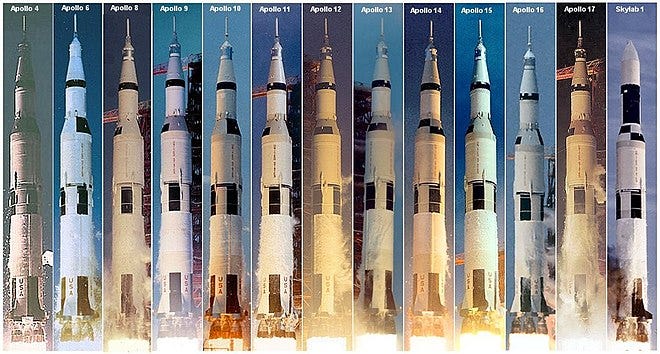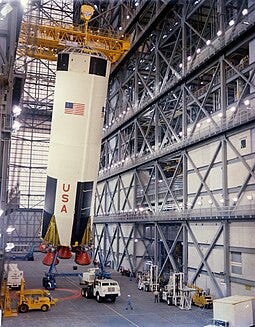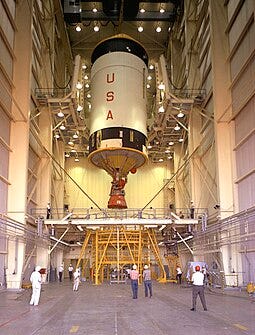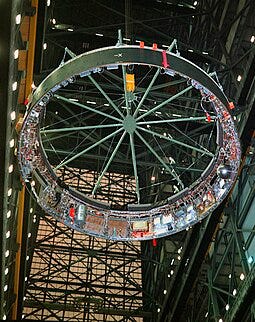For Mercury, the single-stage Redstone rocket was transported to the launch pad and lifted into an upright position with a crane on the pad before technicians attached the Mercury capsule. In Gemini, the Titan II booster was inserted horizontally into the launch tower before the tower was lifted into a vertical position on the pad. The Gemini capsule was then lifted by a crane atop the stack.
But the Saturn V was far too big to lift vertically on the pad after being assembled. The earlier Saturn I rockets were assembled vertically directly on Pad 34 or Pad 37. The Saturn V required something more complicated.
The process began after the stages arrived at the Cape. Both the S-I first stage and the S-II second stage had to be shipped by sea. The S-IC was assembled at the Michoud facility in New Orleans. Without fuel, it weighed 303,000 pounds. It was 138 feet high and 33 feet in diameter. After undergoing a variety of tests, it was floated on a barge 932 miles across the Gulf of Mexico, through the Florida Keys and up the Intracoastal waterway to Port Canaveral.
The S-II second stage, which was assembled in Seal Beach, California, weighed 95,000 pounds without fuel and was 81.58 feet long and 33 feet wide. Once assembled, it was transported over a four-lane highway to the Seal Beach Naval Weapons Station where it was loaded aboard a barge and shipped via the Panama Canal to the Mississippi Testing Facility. From there it followed the same sea route to Port Canaveral.
The S-IVB weighed 33,600 pounds unfueled. It was 21.67 feet wide and 58.58 high. It was assembled by Douglas at its facility in Huntington Beach, California and then flown for testing in Sacramento about a B377 Guppy transport. After that, the S-IVB was flown to Florida.
The Saturn V instrument unit, which contained the various computers and instruments needed to guide the rocket, had been designed at Marshall and built by IBM in Huntsville. It was small, only three feet high and 21.67 feet in diameter. It weighed in at 4,500 pounds. After testing in Huntsville, it was flown to the Kennedy Space Center.
The three stages and the instrument unit were taken to the VAB and went through a thorough series of tests to ensure they hadn’t been damaged in transit. The S-II and S-IVB would be hauled upright and placed in a low bay stand for testing, which would take several weeks.
Meanwhile, the S-IC first stage would checked-out in a horizontal position. Braces were added for stability before two cranes were attached at either end of the S-IC. Then the cranes slowly lifted it into a vertical position. The larger crane would then lower it carefully onto one of the three two-story Mobile Launcher Platforms.
Steel arms were used to anchor the stage to the MLP. Service arms from the 446-foot tall Umbilical Tower on the MLP were attached to the S-IC, providing fuel, power and communications links. Work platforms were moved into position around the stage to provide access for the technicians.
The S-II stage would then be moved into place and lifted over the S-IC and then lowered gently into position. This was a delicate process. A senior engineer for the team guiding the crane later said his crew was trained “to the point where they could conceivably lower the crane-hook on top of an egg, without breaking the shell.”
The S-IVB was next, followed by the instrumentation unit.
The Apollo Command and Service modules, built by North American Aviation in Downey, California and the Lunar Module, built at Grumman’s facility in Bethpage, New York, were both flown in and delivered to the Operations and Checkout Building. After inspections and testing, the Lunar Module was lowered into the 28-foot high Spacecraft-Lunar Module adapter built by North American. The Service Module would be set into place and attached to the SLA. Then the Command Module would then be attached, and the entire assembly rolled over to the VAB where it would be lifted into place on top of the instrumentation unit.
The crowning touch was the Launch Escape System, the 32.5-foot tall solid-fuel rocket emergency abort system. It included the Boost Protective Cover, a fiberglass shell that fit over the Command Module, providing structural and aerodynamic shielding.
In the following weeks, the Saturn V would undergo thousands of inspections and tests to assure everything was ready for the mission.
Then it was time to move the whole thing out to Launch Complex 39. This involved one of the enormous two crawler-transporters which were designed to carry the Saturn V, atop the Mobile Launch Platform, the three miles from the VAB to the launch pad. A hydraulic system was used to keep the Platform almost perfectly level as it moved up the fire percent grade to the pad. The entire trip took five hours.
The transporter-crawler would be moved back to pick up the 410 foot tall Mobile Service Structure and move it into place for the final checkout. Before launch, the MSS would be moved back 6,900 feet.







wow!